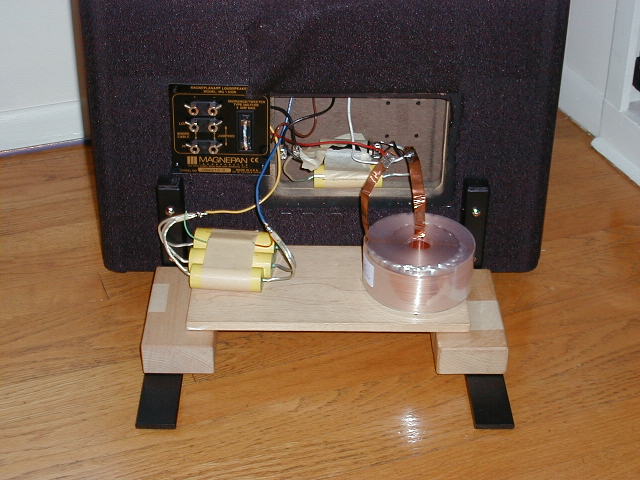
Decisions
The are so many variables, it is best to test out the changes step by step. Strongly recommended to connect the caps and inductors to the orignal wiring and then experiment with the other changes you wish to make.

Bi or Single Wire
The Maggie crossover is a Parallel crossover which suitable and effective for biwiring
The sonic advantages of of bi-wiring are greater clarity of mid and hi frequencies. You can search for Jon Risch's posts at AudioAsylum.com on the subject
The disadvantage is added cost of another pair of speaker wires and an additional set of speaker terminals.
To fuse or not to fuse ?
The sonic degradation casused by the standard fuse and fuse holder is quite considerable. Eliminating the fuse will have about 10 to 15 % of the sonic impact of the cap upgrade. If you want to keep the fuses, look for a higher quality fuse holder and use fuses which are plate or foil instead of the standard resistance wire fuses. Another option is to use bridged fuses when listening "under control" and functional fuses at other times. Fuses can be bridged with 6 strands of CAT 5 LAN cable with good sonic results. see MUG fuse tweak
Adding a 0.1 mfd bypass cap to the tweeter caps will add more sonic "Zing" to the sound. This Zing will make good recordings sound worse, but it can quite nicely elevate the presentation of a poor detail deficient recording. If you listen to some not so good recordings, you may want to add a bypass cap which can be switced in and out with a toggle switch (silver contacts preffered)
Woofer Shunt Cap
The stock shunt capacitor is a very small 25 mfd electrocube. Replacing it with a 5 mfd Hovland and a 20 mfd Solen PB yields sonic changes and beneifits (replacement caps have 6 times the physical volume of the original). There is an increase in detail and resolution. On my system, the emotional quotient increases quite noticeably. There is more texture to the midrange, with the music sounding less filtered. There is a price to be paid however. The woofer shunt caps take a long time to break in due to the low current going through them. It's best to break them in connected in series with a speaker on another system for at leat 24 hours before installing them on the 1.6's. This is very worthwhile doing if you like detail. Internal mounting of components becomes impossible.
If you like a silky smooth sound then stick to the stock electrocube.
Internal or External mounting of Caps and Inductors
Internal mounting is the easiest to do and involves the least work. Disadvantages are, you can not easily restore the original crossover (all of the original parts must be removed), and the foil inductor will protrude out from the back. It is quite a tight squeeze as the crossover space is only 7.5 inches wide by 4.5 inches tall.
External mounting requires making or getting 2 boxes to put the caps and inductor in. However with an extrnal box you can vibration damp the crossover (see Sand Damping).
Sand Damping
The sonic performance of caps and inductors is vibration sensitive. Effective vibration damping of these components improves transient attack quite noticeably. Percussion instruments, snare drums especially, will have more "bite". There is no noticeable difference for vocals and strings.
Do not bury caps, inductors, or wiring in sand but let the rest on a board or polyethylene bubble sheet. Burying in sand noticeably degrades the sonics. Here is a quote from Ric Schultz of EVS
In my experience there is no such thing as a good dialectric. You want the least covering around any signal covering device (this is why the latest[hot rod version]Infinicaps have no end fill and little wrapping). Damping should be done just on the edges or smallest parts of the device so that the damping material does not interfere with the analog wave form. Sand is not a good dialectic, nor is any vibration damping material. Damp yes, but only on the edges or bottom. You want the most air possible around the component. Air is the best dielectric.